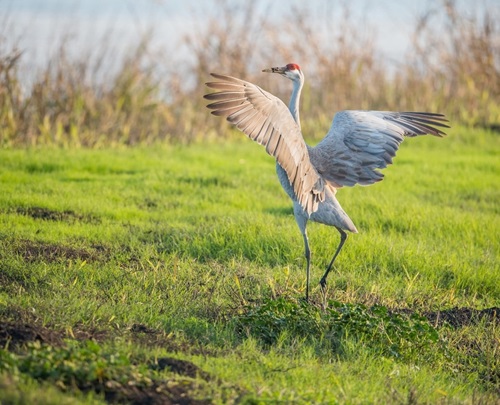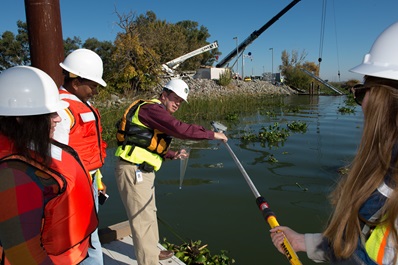Environment

A Sandhill crane wanders near Woodbridge Road in Lodi. DWR/2014.
The environment is made up of living and nonliving elements – air, water, minerals, and organisms – that are located in a specific area or broadly across a landscape. Human activities often affect the environment.
Water is an essential part of the environment and a requirement for all living organisms. California’s water resources, combined with a unique geography and climate, foster a diverse habitat with an equally diverse ecosystem of plants, animals, fish, birds, and aquatic life.
The body of water (e.g., stream, lake, river, ocean) and water type (e.g., fresh, brackish, saline) in a landscape, along with climate and other factors, have a profound effect on the distribution and life history of organisms.
Changes in water conditions, such as flow, salinity, and temperature, affect species that live there. For example, there are many types of fish that thrive in freshwater, but not in saline water. And many fish species, including salmon and steelhead, are highly influenced temperature changes, which affect their growth, feeding habits, migration patterns, spawning, and rearing.
Water’s impact on the environment is typically the most severe during extreme events, such as floods and droughts.
- During droughts, there is a limited amount of fresh water available for consumption, which can result in adverse impacts, such as less water for agriculture and a decrease in the amount of freshwater that is released for migrating fish species.
- Floods can impact human health and safety and alter the environment, but can also be beneficial. Our scientists have published research that demonstrates floodplains are important rearing grounds for native fish. The Yolo Bypass, which serves an important flood control function, invites salmon to feed in the food-rich floodplain enabling them to quickly grow and improving their survival rate.

Our Environmental Work
DWR works to meet California’s drinking water, agricultural, and economic water supply needs while limiting negative impacts and benefiting the state’s natural environment. This is especially important during times of flood, drought, and other major environmental changes involving California waterways and water supplies.
We do this by:
- Restoring the natural landscape
- Monitoring and mitigating impacts to sensitive, threatened, and endangered species
- Monitoring and managing water quality parameters that are important for aquatic life
- Checking for environmental water quality, which includes ecosystem health, recreation, salinity intrusion, and treatment costs
The State Water Project (SWP), the largest state-built and operated multipurpose water storage and conveyance project in the U.S., has become an integral part of California’s landscape. The SWP is operated to minimize environmental impacts, and even improve conditions through habitat restoration projects, mitigation agreements, fish screens and passages, restricted pumping schedules, and more.
The heart of California’s water system is Sacramento-San Joaquin Delta. DWR's Bay-Delta Office is dedicated to planning SWP facilities and implementing actions in the Delta that improve water quality, water supply and reliability, and the ecosystem.
DWR's Division of Environmental Services conducts research and analyses to support water and resource management throughout California that balances both human and environmental needs.
Resources
Delta E-News
Sign up at deltanews@water.ca.gov
